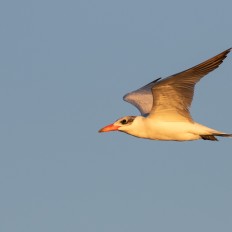The Dixon Lake Unit of Pedlar WMA is situated West 10 miles of Star City and features a varuety of habitats. On it sits a 14 acre lake, a smaller year round wetland/pond, and another smalle seasonal wetalnd. The seasonal wetaland is situated to the right of the entrance road along route 7. In the wetter months the wetland fills with water and often has a couple Wood Ducks or a Great-blue Heron in it. In the fall, many sparrows gather here to feed and in the wetter sections the occasional Marsh Wren shows up. The other two ponds often have at least a couple waterfoul species throughout the year. The most common being Mallard, Wood Duck, and Canada Goose, all of which breed here. If edge habitat is available during spring or fall migration, you might see half a dozen Spotted and Solitairy Sandpipers and maybe even one of the yellowleg species. Throughout spring and into late summer most evenings also host a variety of swallow species. Taking the logging road past Dixon lake leads to an open area with good scrubby/wet edge habitat. On a good fall day, you can get flocks of up to 20 species of warblers here. The willow and alder wetland here is also one of the more reliable places for Yellow-bellied Flyactchers with at least one showing up in the last couple weeks of september. From here you can either take the logging road or Powerline cut up to the ridge. Both of these trails are full of migrants in the spring and offer a great divesity of birds year round. More than 13 species of warblers breed here including Kentucky, Prarie, Worm-eating, and Curealean Warblers.
The Dixon Lake Unit of Pedlar WMA is situated West 10 miles of Star City and features a varuety of habitats. On it sits a 14 acre lake, a smaller year round wetland/pond, and another smalle seasonal wetalnd. The seasonal wetaland is situated to the right of the entrance road along route 7. In the wetter months the wetland fills with water and often has a couple Wood Ducks or a Great-blue Heron in it. In the fall, many sparrows gather here to feed and in the wetter sections the occasional Marsh Wren shows up. The other two ponds often have at least a couple waterfoul species throughout the year. The most common being Mallard, Wood Duck, and Canada Goose, all of which breed here. If edge habitat is available during spring or fall migration, you might see half a dozen Spotted and Solitairy Sandpipers and maybe even one of the yellowleg species. Throughout spring and into late summer most evenings also host a variety of swallow species. Taking the walking trail inlogging road past Dixon lake leads to an open area with good scrubby/wet edge habitat. On a good fall day, you can get flocks of up to 20 species of warblers here. The willow and alder wetland here is also one of the more reliable places for Yellow-bellied Flyactchers with at least one showing up in the last couple weeks of september. From here you can either take the logging road or Powerline cut up to the ridge. Both of these trails are full of migrants in the spring and offer a great divesity of birds year round. More than 13 species of warblers breed here including Kentucky, Prarie, Worm-eating, and Curealean Warblers.
The Dixon Lake Unit of Pedlar WMA is situated West 10 miles of Star City and features a varuety of habitats. On it sits a 14 acre lake, a smaller year round wetland/pond, and another smalle seasonal wetalnd. The seasonal wetaland is situated to the right of the entrance road along route 7. In the wetter months the wetland fills with water and often has a couple Wood Ducks or a Great-blue Heron in it. In the fall, many sparrows gather here to feed and in the wetter sections the occasional Marsh Wren shows up. The other two ponds often have at least a couple waterfoul species throughout the year. The most common being Mallard, Wood Duck, and Canada Goose, all of which breed here. If edge habitat is available during spring or fall migration, you might see half a dozen Spotted and Solitairy Sandpipers and maybe even one of the yellowleg species. Throughout spring and into late summer most evenings also host a variety of swallow species. Taking the walking trail in


